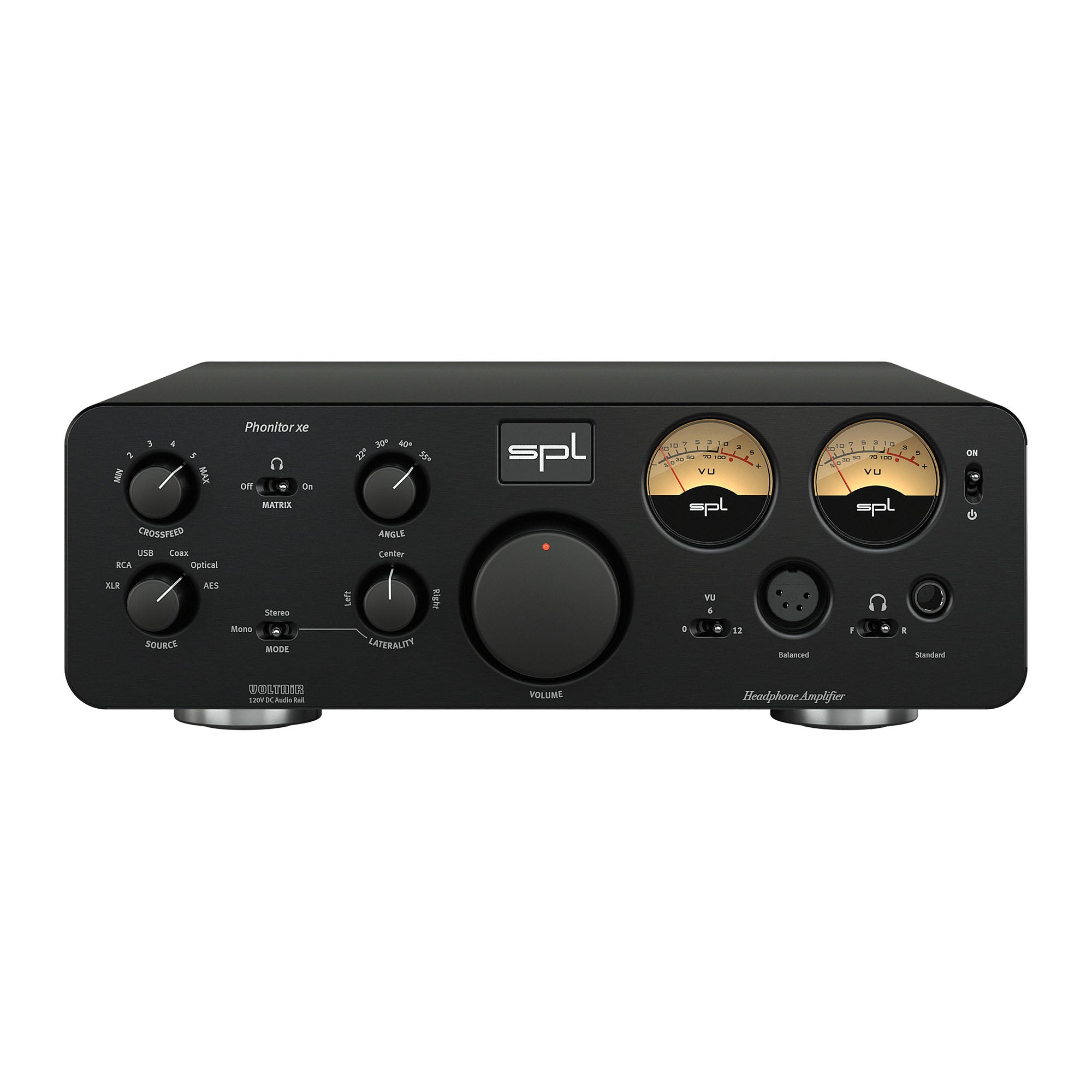

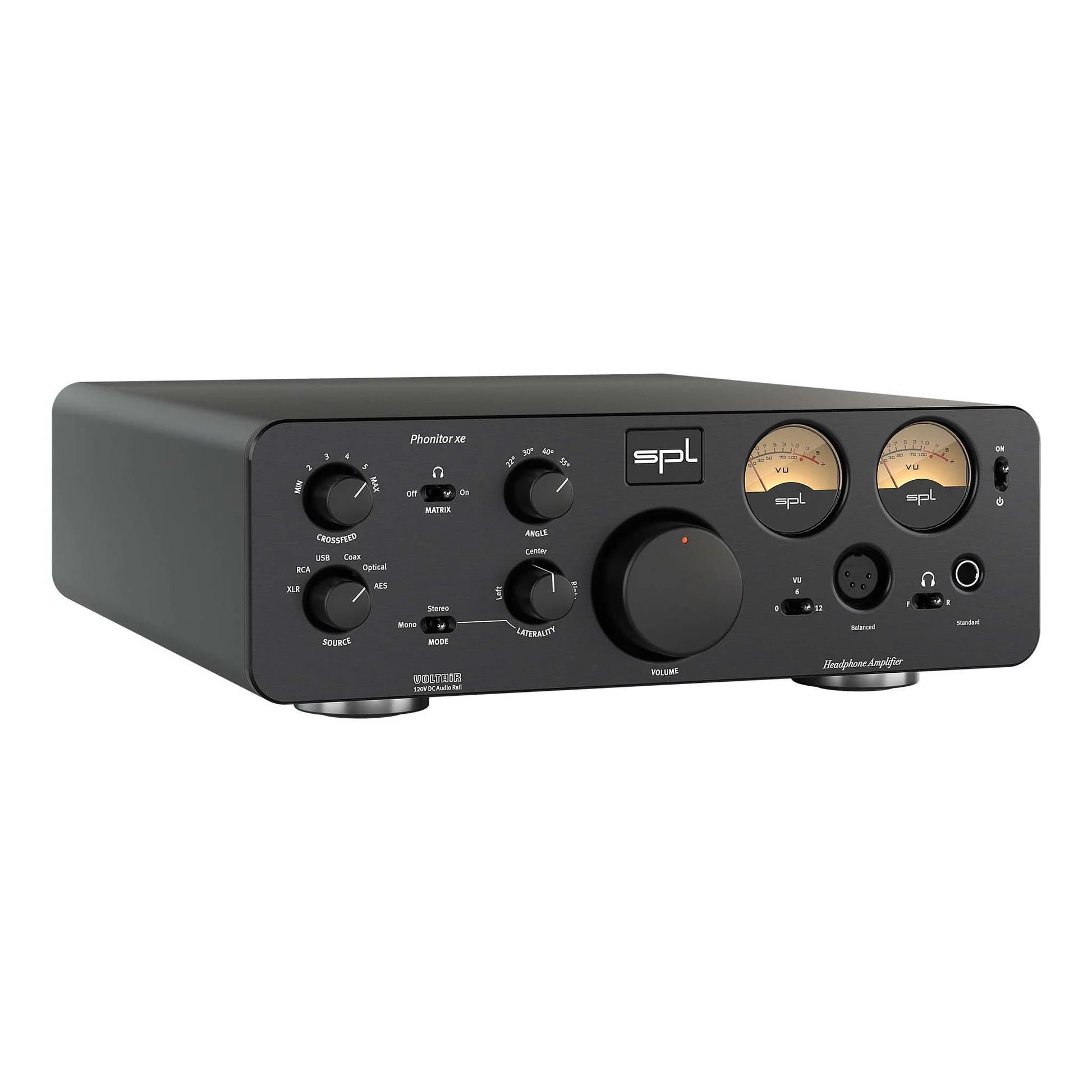
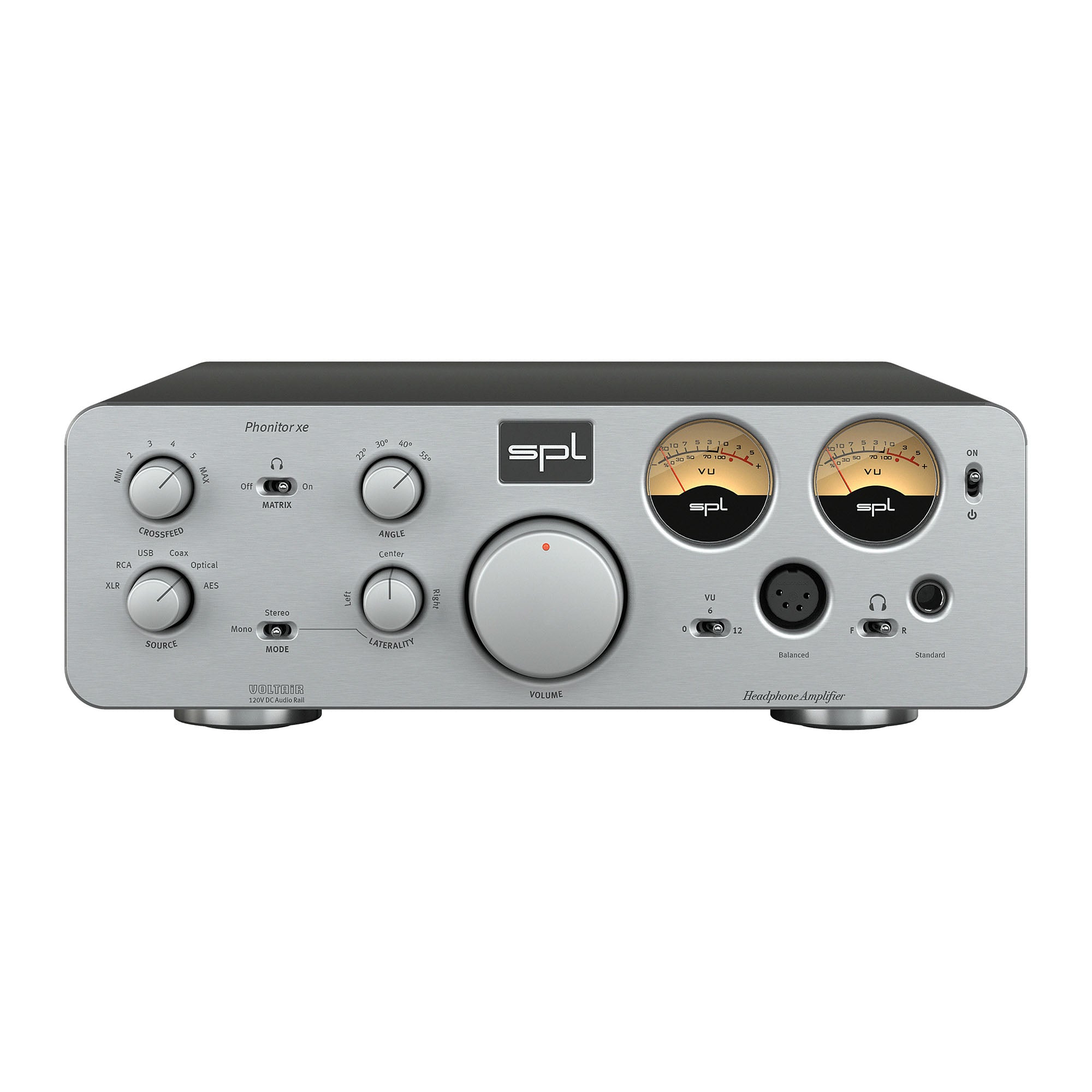
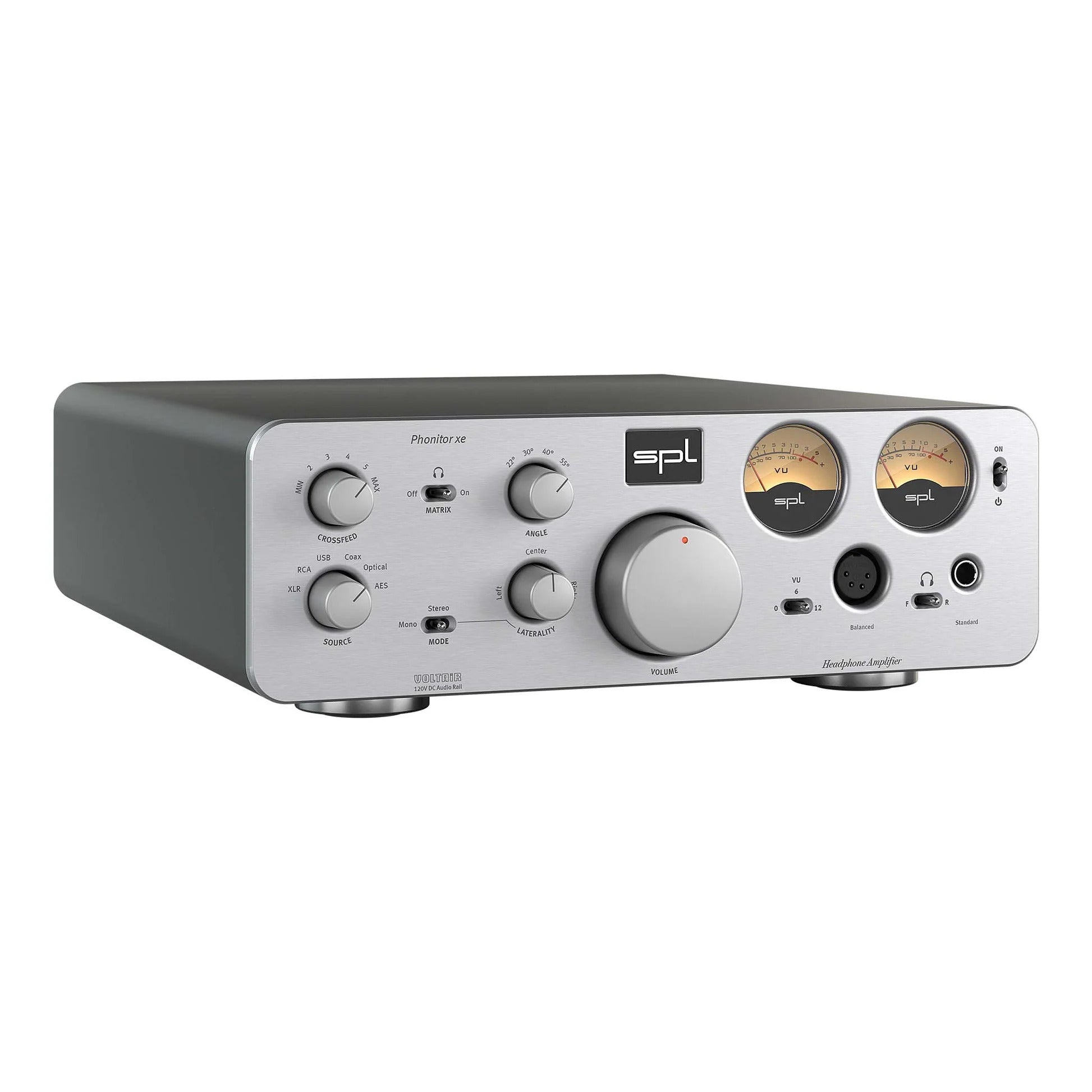
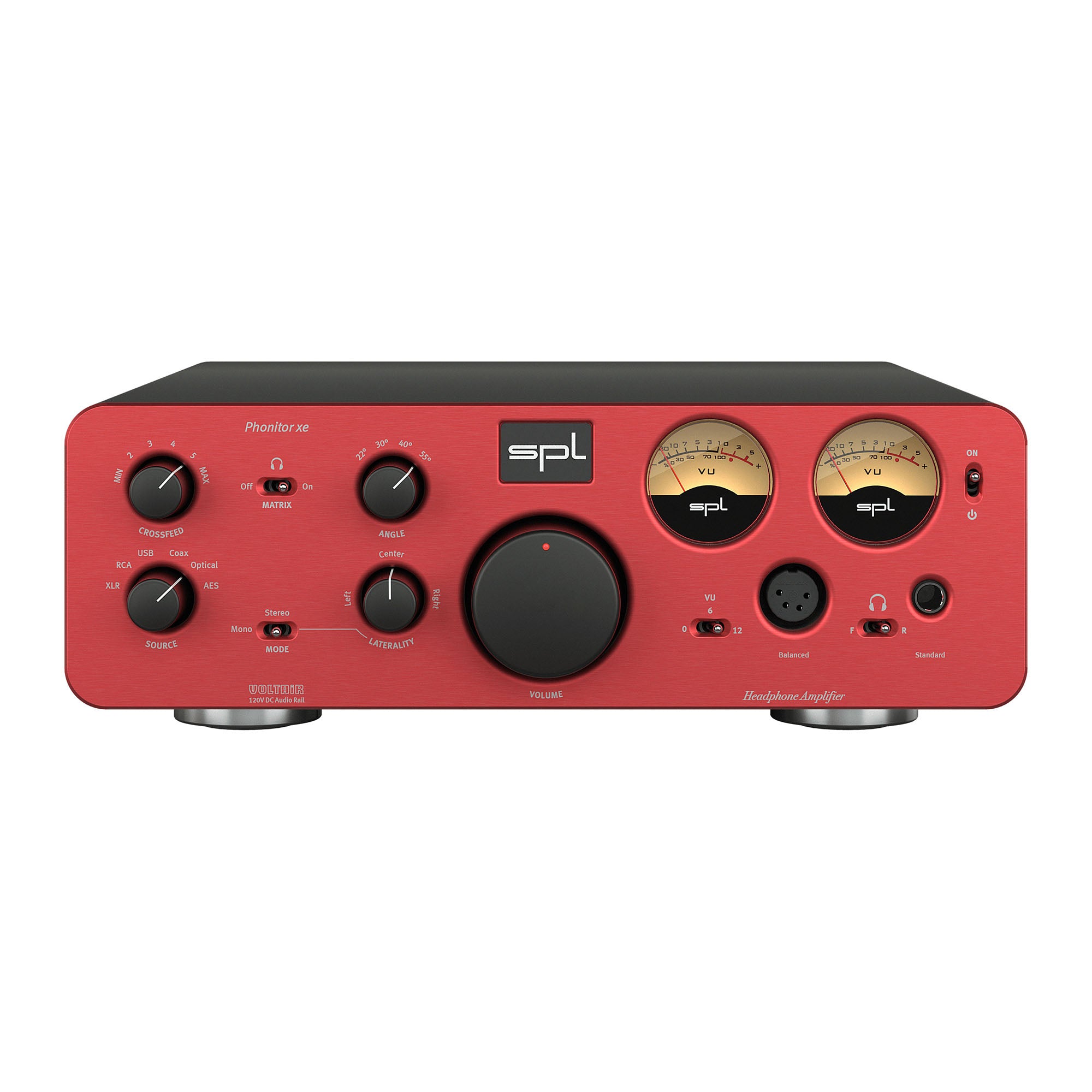
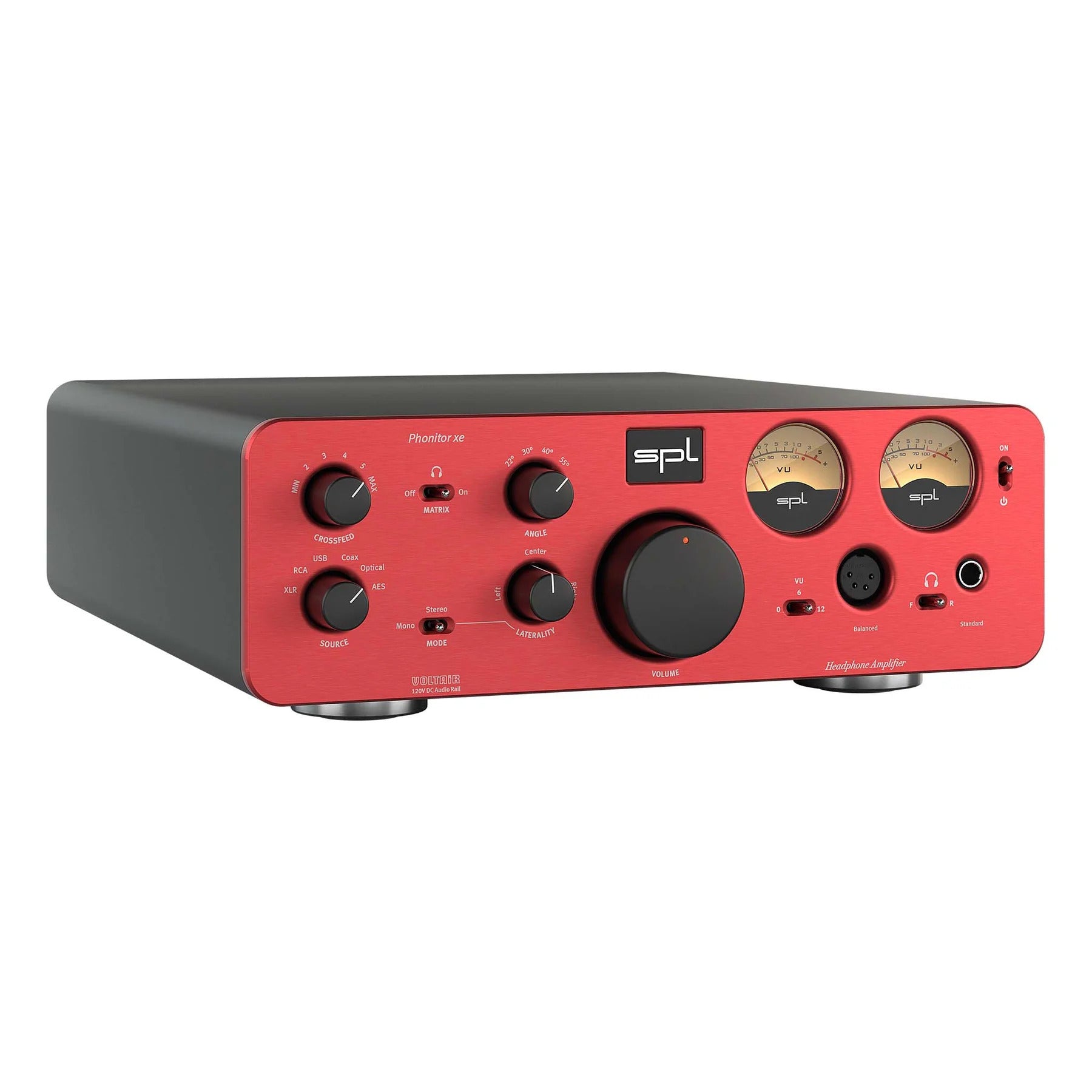
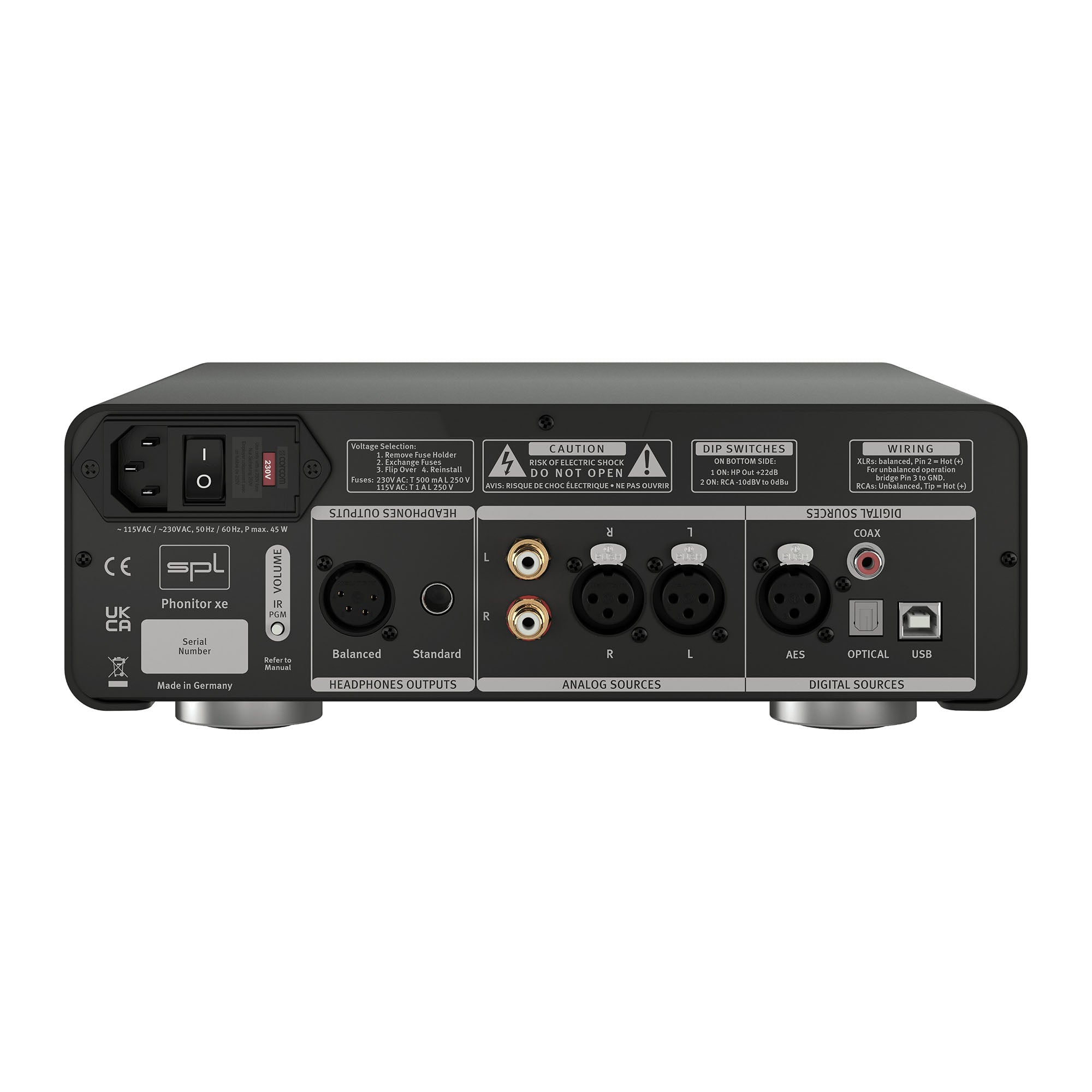

SPL Phonitor xe Headphone Amplifier and DAC
Model
SPL Phonitor xe Headphone Amplifier and DAC
Black / Phonitor xe without DAC786v2
22 Saint Kilda Road
22 Saint Kilda Road
Suite 2.02
St Kilda VIC 3182
Australia

Sound Performance Lab

Phonitor xe
Our nonplusultra headphone amplifier.
The Phonitor xe is the nonplusultra standalone headphone amplifier without any compromises. Phonitor Matrix, remote volume control, retro-look VU meter, the optional premium DA converter and the all-superior VOLTAiR technology make the Phonitor xe one of the best headphone amplifiers of our time.

Reviews

“With the Phonitor xe, SPL delivers the ultimate device for all headphone enthusiasts, who value neutrality, preciseness and control, combined with great musicality.”
Dr. Martin Mertens
EAR IN
“The fineness and transparency with which the music is depicted is just awesome – what a richness of detail!”
Volker Frech
Lite Magazin
“How does the device sound?
Let’s erase all doubts right away:
it sounds fantastic!”
Jürgen Saile
HiFi Statement
“On to the meat of the review though,
how does the Phonitor xe itself actually sound?
To be honest, it’s spectacular.”
Grover Neville
Inner Fidelity
“One way or another, the purchaser of a Phonitor xe receives a reliable high-end solution, which not only drives every kind of headphone on the market without any effort, but also convinces through useful and rare extras like the, in my opinion, still unrivaled crossfeed circuit.”
Benjamin Baum
Fair Audio

Great Sound – for all headphones
The Phonitor xe offers connections for a standard headphone with a stereo jack plug and for balanced-driven headphones using a 4 pin XLR plug.
Thanks to the enormous output power, all headphones are driven effortlessly.
Thus, it plays out the advantages of the SPL VOLTAiR technology and rewards the listener with an honest, detailed and at the same time vivid sound experience.

Twice as nice
The Phonitor xe provides headphone outputs on the front and on the rear. On the front, you switch between F (front) and R (rear). This way, your favorite headphones remain firmly connected on the rear – without visible cabling on the front.
Milled from solid
The massive 45mm volume control knob milled from aluminum is a haptic highlight. Its mass together with the motorized Alps RK27 “Big Blue” potentiometer enhances the “spoon in the honey” feeling even further.
The red marker LED ensures good visibility of the volume parameter even in darkened environments.

Remote control
The volume control can be remotely controlled with any infrared remote control.
The Phonitor xe learns to communicate with it with the simple push of a button.
Learning made easy
Using Phonitor x as an example, this video explains how you can use any infrared remote control to remotely control the volume.

Source of joy
Up to six (6 !) stereo sources can be connected to the Phonitor xe: XLR, RCA and via the optional DAC768 also USB, COAX, OPTICAL and AES.
Phonitor xe accepts almost all audio connections. Balanced via XLR or unbalanced via RCA connectors.
With the optional DAC768, four additional digital sources are added. From USB to professional AES format, no wishes remain unfulfilled.
The DAC automatically picks up the sampling rate and resolution of the digital playback source. No matter if a streamer, computer or CD player is connected. No further settings on the Phonitor xe are necessary.
SPL Phonitor XE Review
DAC768v2 – the SPL reference DAC in the newest revision!

The highly acclaimed AKM AK4493 SEQ VELVETSOUNDTM premium DAC chip is used as the converter chip in the digital/analog converter within the latest version of the SPL DAC “DAC768v2”, which thanks to its architecture reproduces the finest sound details. It impresses with even lower distortion characteristics and a wider dynamic range than its predecessor.
It converts PCM audio with a resolution of 32 bits and a sampling rate of up to 768 kHz, which is equivalent to 16 times CD resolution. Direct Stream Digital is also supported up to a resolution of DSD4 or DSD256. The DAC768v2 features the newest version of the Spartan FPGA – Spartan 7.
In contrast to the smaller SPL DAC “DAC768xs”, it not only offers an AES/EBU digital input, but also the new, optimized SPL SLP120 with VOLTAiR technology.
The SLP120 (Super Low-Pass)

The analog output of the DAC chip must be filtered by a low pass filter. In contrast to all other DACs in the world, the low pass filters here are built using VOLTAiR technology, which provides a plus in dynamics and headroom and sound. The filter specially optimized for the new SPL DAC768v2 is called SLP120 (Super Low-Pass).
The DAC768v2 inside the Phonitor xe is equipped with the SLP120 – an analog “Super Low-Pass” filter with VOLTAiR technology.

DAC768v2 – what's new:
1. AK 4493 SEQ
The DAC768v2 is equipped with the latest generation of the premium DAC chip – the AK 4493 SEQ – from Asahi Kasei (previously AK 4490).
The AK 4493 SEQ not only supports the playback of PCM signals at up to 768 kHz and DSD signals up to DSD512 – this 32-bit stereo DAC with “VELVETSOUND™ technology” impresses with even lower distortion characteristics and a wider dynamic range than its predecessor.
2. Spartan 7
The DAC768v2 features the newest version of the Spartan FPGA – Spartan 7 (previously Spartan 6).
3. The newest generation of the SPL low-pass filter “SLP120”
The DAC768v2 comes with a completely new tuned low-pass filter, which perfectly matches the sonic strengths of the new converter chip. It ofers an even better representation of the stereo image as well as a three-dimensionality we never experienced from any other DAC before.
The new DAC revision can be recognized by the “DAC768v2” label on the serial number sticker.

The design of the DAC768v2 is unfortunately not compatible with devices that were built with DAC768.
In addition to the original DAC chip (previously AK4490, now AK4493), other components in the digital environment that are no longer available, such as the previously used version of the Spartan-6 FPGA (now Spartan-7), had to be updated. As the technical characteristics of these components are different from those of their predecessors, further technical adjustments had to be made to the device in order to achieve the best possible sonic performance of which SPL is known for. The analog low-pass filter with 120V technology is also different in the devices with DAC768v2.
It is therefore not possible to simply replace the DAC768 module with the DAC768v2 module.

Good ol' times
Two mechanical VU meters visualize the input levels for the left and right audio channel.
With the VU switch you can optimize the display for different signal levels.

Finding the middle
is not always easy. By our very nature, hearing can be leaning more to the left or more to the right. This is especially obvious when listening with headphones.
That’s why Phonitor xe has the uniquely finely resolved laterality control. With it, the center can be found perfectly.
With the MODE switch you can choose between stereo or mono playback. This switch also activates the laterality control.

The Revolution: Phonitor Matrix
The Phonitor Matrix is the revolution in the headphone amplifier.

Thanks to the Phonitor Matrix, music can be experienced on headphones as if it was played on speakers. The tiring super stereo effect is a thing of the past.
Enjoy your music without listening fatigue and exactly the way it should be heard.

Phonitor Matrix
Thanks to the Phonitor Matrix, music can be experienced on headphones as if it was played on speakers.

Crossfeed
Listening on headphones is different from listening on loudspeakers.
The biggest difference is the lack of crossing signals of the sound signal from the left speaker to the right ear and from the right speaker to the left ear.

Conventional
This results in an unnaturally wide and wrong stereo image.
The various sound sources of the audio signal are not localized as the sound engineer intended them to.

Correct
The SPL Phonitor Matrix will correct this false stereo image with an analog circuitry and ensures a correct representation of the stereo image and a relaxed listening experience.
Music is normally produced and mixed for playback on stereo speakers.
Listening on headphones is different from listening on loudspeakers. The biggest difference is the lack of crossing signals of the sound signal from the left speaker to the right ear and from the right speaker to the left ear. These crossing signals are missing in conventional headphone listening, because there are no signals crossing from one side of the headphones to the other. This results in an unnaturally wide stereo image and the various sound sources of the audio signal are not localized as the sound engineer intended them to. This effect is often referred to as “super stereo effect”. During conventional listening on headphones, our brain can balance the false representation of the playback to a certain extent – but this is very exhausting.
The SPL Phonitor Matrix can correct this false stereo image with an analog circuitry. The Phonitor Matrix therefore not only ensures a correct representation of the stereo image, but also a relaxed listening experience.
The two main parameters of the Phonitor Matrix are Crossfeed and Angle:
Crossfeed determines the crossing signals of the channels, the so-called interaural level difference.
Angle determines the opening angle of the stereo image, the so-called interaural time difference.
Crossfeed

Level and frequency adjustment of the right (red) and left (green) audio channel at maximum crossfeed.
Angle

Settings for the speaker placement angle to determine the interaural time difference.
Center of Attention
To make the listening experience even more perfect, the level of the center of the stereo image needs to be attenuated when the Phonitor Matrix is active. This ensures that not only the position of all sound sources is correct but also their volume.
In the Professional Fidelity Phonitor devices this value is set to a fixed attenuation of -1 dB, which is the best choice for getting an authentic representation of the sound stage.
Everything you need to know about the Phonitor Matrix
Everything you need to hear about the Phonitor Matrix
SPL Phonitor XE Review

Sounds good!
With all devices of the Professional Fidelity series we develop not only according to plan, but also by ear. All important components are installed on the circuit boards using Through-hole technology. This way we can ensure that we can use the best sounding components.
The VOLTAiR Technology
The 120V technology is our reference technology. The 120V technology is unique in the world. It operates at a DC voltage of 120 volts. This is four times that of IC-based semiconductor op-amps. In our Professional Fidelity series, we refer to this unsurpassed technology as VOLTAiR technology.

The highest possible audio quality requires the highest possible audio operating voltage.
The 120V technology works with +/-60 V. To be able to handle such a high voltage, we have developed special proprietary operational amplifiers that can operate with a DC voltage of +/-60 V: the SPL 120V SUPRA operational amplifiers.
This high voltage would destroy conventional components and operational amplifiers.
By the way, the “120V” in the name of the technology has nothing to do with the local mains voltage from the mains power socket. This is about the operating voltage inside the device with which the audio signals are processed.
The mains voltage from the mains power socket is transformed to the required secondary voltage in the device’s internal linear power supply with toroidal transformer. Rectifiers convert this AC voltage into DC voltage required in the audio device.
This video guides you step by step through Phonitor XE
Analog inputs: XLR (balanced) and RCA
Input gain (max)
32.5 dBu
Input impedance (RCA)
20 kΩ
Input impedance (XLR)
20 kΩ
Common mode rejection ratio (XLR)
82 dB
Digital Inputs: DAC768 (optional)
AES/EBU (XLR), PCM sample rates
44.1/48/88.2/96/176.4/192 kHz
Coaxial SPDIF (RCA), PCM sample rates
44.1/48/88.2/96/176.4/192 kHz
Optical SPDIF (Toslink F06), PCM sample rates
44.1/48/88.2/96/with Glass fibre <1m: 176.4/192 kHz
USB (B), PCM sample rates
44.1/48/88.2/96/176.4/192/352.8/384/705.6/768 kHz
USB (B), DSD over PCM (DoP), sample rates
2.8 (DSD64), 5.6 (DSD128), 11.2 (DSD256) MHz
0 dBFS calibrated to
15 dBu
Balanced Headphones Output: 4-pol XLR (balanced)
Pin wiring
1 = L (+), 2 = L (-), 3 = R (+), 4 = R (-)
Source impedance
0.36 Ω
Damping factor (40 Ω)
180
Frequency range (0 dBu)
10 Hz – 100 kHz
Crosstalk (1 kHz, 0 dBu)
-90 dBu
THD + N (1 kHz, 0 dBu)
0.00082 %
Noise (A-weighted)
-98 dBu
Output power (1 kHz @ 1 % THD, 250 Ω)
2 x 3.5 W
Output power (1 kHz @ 1 % THD, 32 Ω)
2 x 0.7 W
Dynamic range
130.5 dB
Standard Headphones Output: 6.35 mm (1/4") TRS Jack
Pin wiring
Tip = Left, Ring = Right, Sleeve = GND
Source impedance
0.18 Ω
Damping factor (40 Ω)
180
Frequency range (0 dBu)
10 Hz – 100 kHz
Crosstalk (1 kHz, 0 dBu)
-90 dB
THD + N (1 kHz, 0 dBu)
0.00082 %
Noise (A-weighted)
-103 dBu
Output power (1 kHz @ 1 % THD, 250 Ω)
2 x 5 W
Output power (1 kHz @ 1 % THD, 32 Ω)
2 x 2.7 W
Dynamic range
135.5 dB
Internal Linear Power Supply with Shielded Toroidal Transformer
Operating voltage for analog audio
+/- 60 V
Operating voltage for relays and LEDs
+ 12 V
Mains Power Supply
Mains voltage (selectable, see fuse chamber)
230 V AC / 50; 115 V AC / 60 Hz
Fuse for 230 V
T 0.5 A
Fuse for 115 V
T 1 A
Power consumption
max. 40 VA
Stand-by power consumption
< 0.3 W
Dimensions & Weight
W x H x D (width x height incl. feet x depth)
278 x 100 x 300 mm
11 x 4 x 11.81 inch
Unit weight
4.9 kg
10.8 lbs
Shipping weight (incl. packaging)
5.6 kg
12.35 lbs




